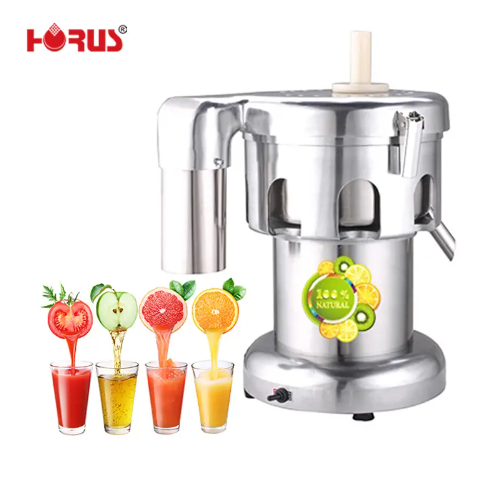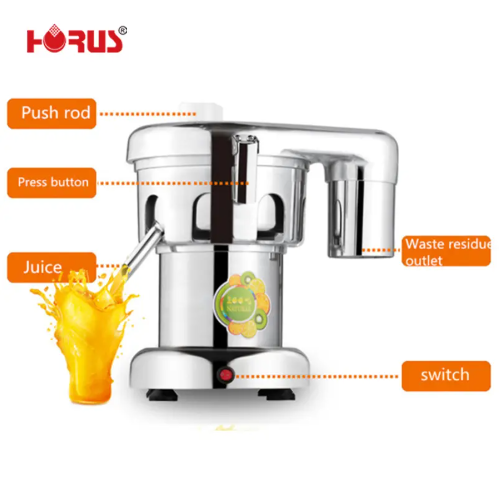close
Choose Your Site
Global
Social Media

Views: 0 Author: Site Editor Publish Time: 2025-09-23 Origin: Site
Juicing has become essential in today’s health-conscious world. With the rise of fresh juices, many face a choice: manual or electric juicers? Understanding yield, cleaning time, and total cost of ownership (TCO) is crucial.
In this post, we’ll explore these factors to help you decide which juicer best suits your needs.
A juicer is a kitchen appliance designed for extracting juice from fruits and vegetables. Its main purpose is to provide a quick way to enjoy fresh juice, packed with nutrients.
There are two main types of juicers: manual and electric. Each has its own unique features and benefits, catering to different preferences and needs.
Manual juicers operate without electricity. They rely on physical effort to extract juice.
● Lever Presses: These juicers use a lever mechanism to apply pressure on fruits, squeezing out the juice.
● Hand-Held Squeezers: Compact and easy to use, these juicers are ideal for small quantities.
Competitor Insight: Using manual juicers requires more physical strength. This can limit juice yield, especially with tougher fruits. For instance, extracting juice from a pomegranate can be quite labor-intensive.
Electric juicers simplify the juicing process. They use motors to automate juice extraction, making it faster and easier.
● Centrifugal Juicers: These use high-speed blades to spin and extract juice quickly. They are great for soft fruits but may not be as efficient with leafy greens.
● Masticating Juicers: Also known as slow juicers, they crush fruits and vegetables to extract juice. This method preserves more nutrients and is effective for leafy greens.
● Cold Press Juicers: These juicers extract juice at low speeds, minimizing heat and oxidation. They are ideal for maximizing nutrient retention.
Competitor Insight: Commercial-grade electric juicers are designed for high efficiency. They can handle large volumes, making them perfect for juice bars and restaurants. The speed and power of these models significantly increase productivity.
With this knowledge, you can better understand the differences between manual and electric juicers. Each type has its strengths, catering to various juicing needs and preferences.

Yield refers to the amount of juice extracted from fruits and vegetables. It’s a crucial factor for both consumers and businesses.
For consumers, higher yield means more juice for less fruit. For businesses, maximizing yield can significantly impact profitability. Understanding yield helps you make informed choices about which juicer to invest in.
Electric juicers excel in juice output. They typically provide 20-30% more juice than manual counterparts. This efficiency is thanks to their powerful motors and advanced technologies.
● Auto-Reverse Technology: This feature prevents clogging and ensures maximum juice extraction.
● Dual Reamers: These allow for better extraction from various fruits, enhancing overall yield.
Commercial Output: In commercial settings, cold press machines can achieve impressive outputs. Some models can produce 40-100+ gallons per hour, making them ideal for busy juice bars.
Manual juicers generally have lower juice output. They yield about 15-20% less juice compared to electric models. This limitation often stems from the physical effort required to extract juice.
● Manual juicers work well for small batches, perfect for home use.
● They are suitable for those who enjoy the process of juicing without the need for large quantities.
Competitor Insight: Manual juicers struggle with fibrous fruits like pomegranates. This can limit their effectiveness in niche cafes that focus on diverse juice offerings.
When comparing yields, electric juicers clearly outperform manual ones. For home users, manual juicers can suffice if you prefer smaller quantities. However, for businesses or heavy juicing needs, an electric juicer is the better choice.
Consider your specific needs when deciding which juicer will provide the best yield for you.
Cleaning your juicer is essential for several reasons. First, it ensures the juice quality remains high. Residue from previous juices can affect the taste and nutritional value.
Second, regular cleaning extends the lifespan of your machine. A well-maintained juicer operates efficiently and lasts longer, saving you money in the long run.
Cleaning electric juicers involves a few simple steps:
1. Disassemble the Juicer: Remove all detachable parts.
2. Rinse Immediately: Rinse parts under warm water to prevent drying residue.
3. Wash with Soap: Use mild soap and a sponge for thorough cleaning.
4. Dry Completely: Let parts air dry or use a towel.
● Home Models: Approximately 5-10 minutes.
● Commercial Models: Around 15-20 minutes.
Many electric juicers feature dishwasher-safe components and quick-release designs. This makes cleanup even easier.
Commercial Durability: NSF-certified electric juicers are built to withstand acidic fruits. They resist corrosion, ensuring durability in busy environments.
Manual juicers require a different approach. Here’s a quick breakdown:
1. Disassemble: Take apart the juicer.
2. Rinse: Rinse all parts immediately after use.
3. Wash: Use soap and a soft brush to clean.
4. Dry: Allow to air dry completely.
● Typically, it takes about 2-5 minutes to clean manual juicers.
Potential Issues: One concern is corrosion, especially from acidic fruits like citrus. To mitigate this, rinse promptly and avoid prolonged exposure to acidic juices.
Competitor Insight: Over time, citrus acid can wear down manual juicers. Regular maintenance is key to keeping them in good shape.
When comparing cleaning times, electric juicers generally take longer due to their complexity. However, their dishwasher-safe parts can save time overall.
Manual juicers are quicker to clean, making them ideal for those who prefer simplicity.
Ultimately, your choice depends on how much time you want to invest in cleaning. If convenience is key, an electric juicer might be worth the extra effort.
Total Cost of Ownership (TCO) is a financial estimate that helps you understand the overall costs associated with purchasing and operating a product over its entire lifespan.
For juicers, TCO includes not just the initial purchase price but also ongoing expenses like maintenance, energy consumption, and potential labor costs. Understanding TCO is crucial when deciding between a manual and an electric juicer.
Electric juicers typically have higher initial costs, ranging from $50 to $200 for home models and $3,000 to $25,000 for commercial types.
● Initial Purchase: Higher upfront investment.
● Long-Term Savings:
○ Labor Costs: Electric juicers require less manual effort, reducing labor fatigue.
○ Higher Yield: They extract more juice, maximizing your return on investment.
○ Warranty Benefits: Many come with warranties, providing peace of mind.
● Energy Efficiency: Many electric juicers use low-speed motors, costing less than $1 per day in operational expenses for commercial use.
Manual juicers are generally more affordable, with initial costs between $10 and $50. However, there are hidden costs to consider.
● Initial Purchase: Low upfront cost.
● Hidden Costs:
○ Labor Fatigue: Manual juicing can be physically taxing, leading to potential labor costs.
○ Lower Juice Yields: Less efficient extraction means you spend more on fruits.
For businesses juicing over 50 lbs per day, the lower efficiency of manual juicers can significantly impact profitability.
Competitor Insight: After 6-12 months, the TCO of manual juicers often surpasses that of electric juicers for businesses due to labor and yield inefficiencies.
In summary, electric juicers generally provide a better Total Cost of Ownership, especially for businesses and regular juicers.
They may have a higher initial cost, but the savings in labor, higher yield, and lower operational costs make them a more economical choice in the long run.
For consumers who juice occasionally, manual juicers might still be appealing due to their low upfront costs. Consider your juicing habits and needs when making your decision!

Electric juicers offer a range of features that make them ideal for cafes and juice bars. Here are some key benefits:
● Speed and Efficiency: They can produce juice quickly, which is essential during peak hours.
● Durability: Built to withstand heavy use, electric juicers are often designed for commercial settings. They comply with industry standards, ensuring safety and reliability.
● Wide Chutes: Many electric juicers come equipped with 88mm-wide chutes, allowing whole fruits and vegetables to be processed without pre-cutting. This saves time and enhances workflow.
● Quiet Motors: Electric models often feature quieter motors, creating a pleasant atmosphere for customers while maintaining efficiency.
Manual juicers cater to a specific audience. They appeal to:
● Budget-Conscious Users: With lower initial costs, manual juicers are perfect for those looking to save money.
● Portability: Lightweight and compact, they are easy to transport, making them ideal for small kitchens or outdoor use.
However, manual juicers have their downsides:
● Scalability: They aren't suitable for high-volume production. If a cafe or juice bar needs to serve many customers quickly, manual juicers fall short.
● Production Capacity: The time and effort required to extract juice manually limit the amount produced, making it challenging for businesses to keep up with demand.
In the competitive landscape of juicers, electric models shine in commercial settings, while manual juicers hold their ground in niche markets. Each type has its strengths, catering to different consumer needs and preferences.
In this article, we explored the key aspects of manual and electric juicers.
We discussed yield, cleaning time, and Total Cost of Ownership (TCO).
Electric juicers generally offer higher yields and lower long-term costs, while manual juicers are budget-friendly and portable.
Ultimately, it’s essential to assess your needs.
Consider factors like usage frequency and desired juice volume.
Make an informed decision that suits your lifestyle and preferences!
A: Electric juicers are often best for beginners due to their ease of use and efficiency.
A: Yes, electric juicers offer higher yields and save time, making them a worthwhile investment.
A: Regularly clean it after use, check for wear, and follow the manufacturer's instructions.
A: Some electric juicers can make nut milk, but check for specific features before purchasing.
A: Popular choices include apples, carrots, leafy greens, and citrus fruits for optimal flavor and nutrition.